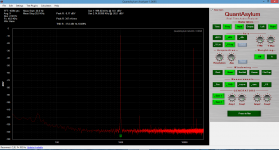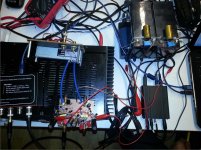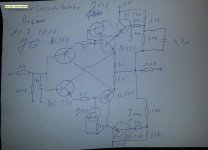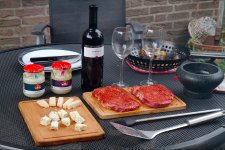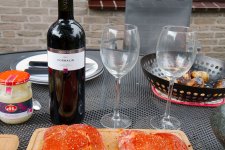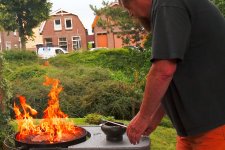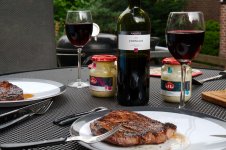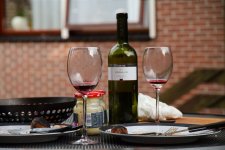I did not show much circuits recently. One reasson is that my love to build speakers came back. I did a lot speakers recently and that takes time.
When i left Sonics several years ago i was a bit frustrated to build even more speakers so i focussed on electronics. I did an amp here and there, my version of the TSSA and the Nobrainer Opamps based amp but my forte is Phonos, Linestages and BUFFERS.
My occupation with buffers is famous ( or should i say infamous ) and i must have shown here dothends.
So why a new buffer ?
The Calvin and the Keantoken are fine but that are not my designs.
Also to build my standart buffer, a modified JLH, got much harder because the 2SJ74 is now nearly imposible to get and the Linear System substitude is not as good as i hoped for.
Anyway, one good and cheep way is the BJT diamond buffer.
I build a lot of varieties, the Piglets Dad, the Mr. Evil, the Mike B and others.
Audible problem in diamond buffers for me is that they produce more uneven distortion
( like 3rd and 5th ) then even distortion ( like 2nd and 4th ) so they tend to sound very dymamic and crispy but sometimes also a bit harsh.
So i set down to make a diamond that has mainly 2nd harmonic.
The design i came up with is not totally new.
For example Dadod has shown circuits like this.
Unfortunately i see mostly simulations only and no real measurements.
I think i have a circuit now that works.
Mind you, this does not come out of the simulator.
I just build it with my intuitive feeling about circuits and some experience.
It may well be that some of you are able to improve it or find a better dimensioning of the part values. Commends are wellcome.
When i left Sonics several years ago i was a bit frustrated to build even more speakers so i focussed on electronics. I did an amp here and there, my version of the TSSA and the Nobrainer Opamps based amp but my forte is Phonos, Linestages and BUFFERS.
My occupation with buffers is famous ( or should i say infamous ) and i must have shown here dothends.
So why a new buffer ?
The Calvin and the Keantoken are fine but that are not my designs.
Also to build my standart buffer, a modified JLH, got much harder because the 2SJ74 is now nearly imposible to get and the Linear System substitude is not as good as i hoped for.
Anyway, one good and cheep way is the BJT diamond buffer.
I build a lot of varieties, the Piglets Dad, the Mr. Evil, the Mike B and others.
Audible problem in diamond buffers for me is that they produce more uneven distortion
( like 3rd and 5th ) then even distortion ( like 2nd and 4th ) so they tend to sound very dymamic and crispy but sometimes also a bit harsh.
So i set down to make a diamond that has mainly 2nd harmonic.
The design i came up with is not totally new.
For example Dadod has shown circuits like this.
Unfortunately i see mostly simulations only and no real measurements.
I think i have a circuit now that works.
Mind you, this does not come out of the simulator.
I just build it with my intuitive feeling about circuits and some experience.
It may well be that some of you are able to improve it or find a better dimensioning of the part values. Commends are wellcome.
I have it now playing in my system.
It has extraordinary slamm and no harshness.
For now i am happy.
It has extraordinary slamm and no harshness.
For now i am happy.
I have it now playing in my system.
It has extraordinary slamm and no harshness.
For now i am happy.
Someone posted that kind of schematic some time ago. Btw, I use the same diamond buffer without cascodes and there`s no uneven distortion, no harsh sound etc. Have you tried it without cascodes?
Cheers Borko.
Actually your circuit is the basis for this buffer.
It is not a new circuit anyway. I saw it first in a Hawsksford designed phono stage at the end of the 80th. There are other variaties.
I build your version first.
It is very good for such a simple circuit.
The circuit in post 9883 has some advantages though.
When you read post 9881 my version also has prerunners like the one Dadod made.
I knew the idea before i saw Dadods circuit from a book by Douglas Self where he bootstraped an IC Opamp ( i think it was a simple TL071 ) for stunning results.
It is not a new circuit anyway. I saw it first in a Hawsksford designed phono stage at the end of the 80th. There are other variaties.
I build your version first.
It is very good for such a simple circuit.
The circuit in post 9883 has some advantages though.
When you read post 9881 my version also has prerunners like the one Dadod made.
I knew the idea before i saw Dadods circuit from a book by Douglas Self where he bootstraped an IC Opamp ( i think it was a simple TL071 ) for stunning results.
Last edited:
So where is the difference to your version ?
First i replaced your 15kOhm bias resistors with JFet constant current sources.
That improves PSRR and lowers distortion.
Then there are the outer bootstrap transistors.
Instead to reference the cascode bias to ground it is refferenced to the output.
You can see that as a driven cascode.
Another point of view is that they make a copy of the output signal and modulate the supply to the buffer with that signal.
Theoretical such a power supply bootstrap can reduce the distortion to Zero because the Ube diodes in the diamond are more or less distortion free.
First i replaced your 15kOhm bias resistors with JFet constant current sources.
That improves PSRR and lowers distortion.
Then there are the outer bootstrap transistors.
Instead to reference the cascode bias to ground it is refferenced to the output.
You can see that as a driven cascode.
Another point of view is that they make a copy of the output signal and modulate the supply to the buffer with that signal.
Theoretical such a power supply bootstrap can reduce the distortion to Zero because the Ube diodes in the diamond are more or less distortion free.
Last edited:
Here is a PDF about boootstrapping opamps.http://joebrown.org.uk/images/DualPSU/BootstrappingOpAmps.pdf
The first circuit is more or less the Self solution.
The first circuit is more or less the Self solution.
Advantages ?
In my book better power supply rejection and lower distortion.
It also sounds very good, very dynamic and high resolution but that is purely subjective.
In my book better power supply rejection and lower distortion.
It also sounds very good, very dynamic and high resolution but that is purely subjective.
It is also possible to bootstrap the input.
That requires an Opamp buffer that drives the bootstrap transistors.
That requires an Opamp buffer that drives the bootstrap transistors.
Attachments
Wow, that seems to be a really nice wine.
Poor me, i work.
I have put now the buffer in my analog chain.
Spiral Groove SG1 with Atlas.
Suesskind Rauschfrei Phono.
LA Audio tube mono block.
German Speaker.
More or less the same result as CD.
Very good dynamics and extention.
Good resolution and full tone.
I just have drawn up a version that is driven by the input.
Schematic later.
It could be even driven by the difference of the input and output.
Maybe this idea is crazy. It certainly gets more complex from this point on.
Poor me, i work.
I have put now the buffer in my analog chain.
Spiral Groove SG1 with Atlas.
Suesskind Rauschfrei Phono.
LA Audio tube mono block.
German Speaker.
More or less the same result as CD.
Very good dynamics and extention.
Good resolution and full tone.
I just have drawn up a version that is driven by the input.
Schematic later.
It could be even driven by the difference of the input and output.
Maybe this idea is crazy. It certainly gets more complex from this point on.
Advantages ?
In my book better power supply rejection and lower distortion.
It also sounds very good, very dynamic and high resolution but that is purely subjective.
That wasn`t my question, I was curious about FFT compared to non cascoded buffer. If you`re happy that`s good enough 🙂
